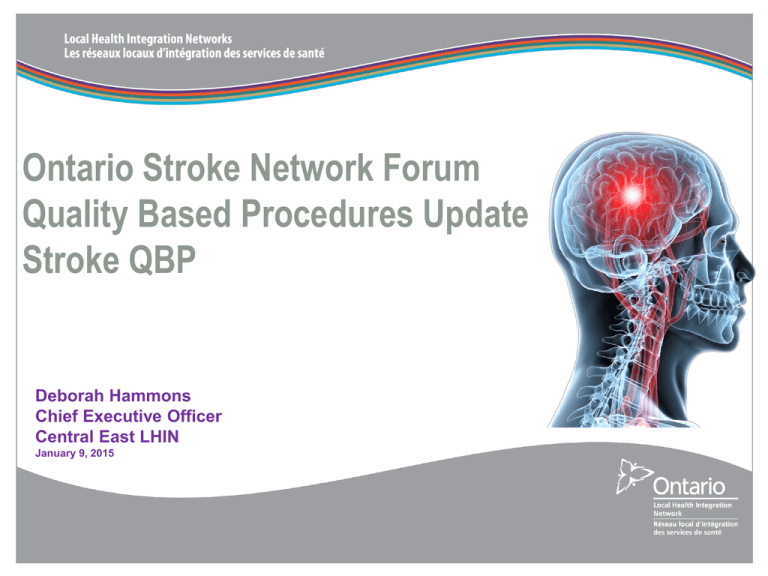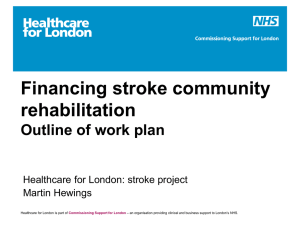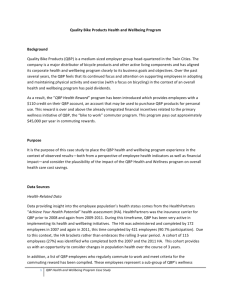
Ontario Stroke Network Forum
Quality Based Procedures Update
Stroke QBP
Deborah Hammons
Chief Executive Officer
Central East LHIN
January 9, 2015
Successes in LHIN QBP Implementation to Date
Champlain, Mississauga-Halton and South West LHINs have pursued stroke
QBP IDEAS projects (timely transfer, rehab intensity, stroke centre identification)
Waterloo Wellington LHIN worked with Stroke Network to flow all stroke patients
to designated acute and rehab stroke centres with standardized care pathways that
include outpatient rehabilitation – now meeting QBP LOS targets with reduced ALC.
North Simcoe Muskoka LHIN - engagement forums identified three acute stroke
centres for stroke unit care. Community based and outpatient day rehab programs
being planned.
Central East LHIN working on funding reallocations in relation to acute stroke unit
care. (Guests at our Sept Regional meeting)
HNHB, Toronto Central LHINS have led LHIN-wide system integration work e.g.
“Stroke Patient Flow” including identification of stroke centres and standardized
transparent systems for referral to rehab.
NE, ESC, SW, M-H, HNHB, Champlain, CW, CE, WW, NSM, Central LHINS:
formal reviews of rehabilitation services for recommended rehab system change
2
Implementation of Best Practices
•
Some of the key issues for and barriers towards successful implementation of the stroke
best practices
•
Recommendations include, but not limited to:
• A transitional approach to funding is recommended to enable building of capacity in
the community
• Each LHIN will need to consider consolidation of stroke care in a fewer number of
hospitals in their region
• Transportation services will need to be in place to support access to rehab services
• The location of Telestroke sites will need to be considered
• Collaboration will need to occur between “stand-alone” rehab facilities and referring
sites to facilitate timely transfer
•
Barriers include, but not limited to:
• If changes in length of stay and discharge into community are not achieved, it may
be difficult to increase the number of patients seen in stroke units
• To provide 7 day-per-week admission to inpatient rehab, access to pharmacy,
dietary and medical coverage, among others, will need to be available
• Human resource shortages
3
Comments from Health Service Providers (1)
Early adopters followed the OSN guidelines and had already started
the implementation of best practices for stroke
Key enablers for implementation included the OSN
Recommendations and Guidelines and QBP Stroke Clinical Handbook
Most of the hospitals had a dedicated stroke unit; some are planning
to reallocate stroke beds and work collaboratively with their referral
and community partners
Most had a dedicated team of health professionals (i.e. MD, Nurse,
OT, PT, SLP, dietician, SW) and had organized QBP governance
structures (e.g. Steering Committee) with cross-membership from
physician leadership, clinical teams, decision support teams etc.
4
Comments from Health Service Providers (2)
Some indicators for stroke are arbitrary and may not show improvement in
stroke outcomes
Need to link quality of patient experience with stroke QBP
Need to reinvest in primary and secondary prevention
Stroke assessment requires resource intensive assessment; consultation
should be recognized
Concerns over impact on funding and operations especially as it relates to
patients with multiple comorbidities
5
Some Specific Quality/Process Improvements
Standardized language across the organization re best practices
Improvements in coding, data collection and quality (i.e. regular chart
audits decreased number of unspecified strokes, physician
documentation improved)
Use of Order Sets advantageous
Key performance indicators were developed and teams were educated
(i.e. use of dashboard or scorecard, discussed at rounds)
Referral to stroke prevention clinics from ED
Greater emphasis in working to understand variations in practice
6
Some Specific Barriers/Challenges (1)
Challenges with Computed Tomography Angiography (CTA) utilization
Difficulty referring patients to rehab with low AlphaFIM® scores, with
complex or cognitive deficits
Swallowing assessments and Dysphagia screening
Over occupancy in stroke unit, patient have to be bed spaced in a nonstroke bed
Access to rehab: Difficulty accessing rehab for patients with cognitive
deficits, risk for falls, etc.
Workload for Allied Health therapists
7
Some Specific Barriers/Challenges (2)
Challenges for the hospitals administering tPA
May have to transfer patients farther from their home; Difficulties with
managing severe strokes with cognitive/physical impairments
Tendency to have higher % of ALC due to limited availability of
inpatient rehabilitation or long-term care beds; Also, working closely
with CCAC to facilitate discharges (e.g. HomeFirst); bed management
is an issue
In some hospitals, there is a lack of follow-up care (i.e. stroke
prevention, outpatient services)
Coding challenges and different definitions of stroke exist (i.e. CIHI
versus OSN versus QBP)
8
Overarching QBP Implementation Challenges
Equitable access to timely rehabilitation services
Limited community services particularly in
remote communities
9
Questions?
10









